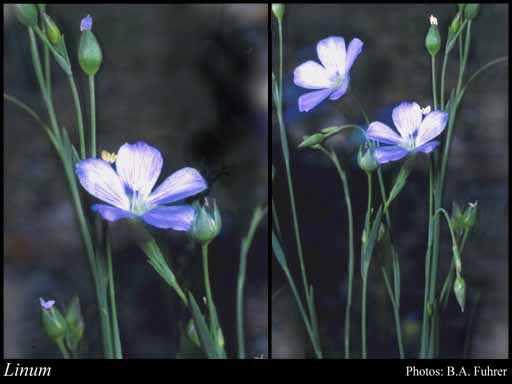- Reference
- Sp.Pl. [Linnaeus] 2:277 (1753)
- Name Status
- Current

Scientific Description
Family Linaceae.
Habit and leaf form. Herbs. Annual, or perennial. Mesophytic, or xerophytic. Leaves alternate; spiral; sessile; non-sheathing; simple. Leaf blades entire; narrow. Leaves with stipules, or without stipules. Leaf blade margins entire. Leaves without a persistent basal meristem. Stem anatomy. Nodes tri-lacunar. Secondary thickening developing from a conventional cambial ring.
Reproductive type, pollination. Fertile flowers hermaphrodite. Unisexual flowers absent. Plants hermaphrodite.
Inflorescence and flower features. Flowers aggregated in ‘inflorescences’; in cymes, or in corymbs, or in panicles. The terminal inflorescence unit cymose. Inflorescences leaf-opposed. Flowers pedicellate; ebracteate; regular; 5 merous; cyclic. Free hypanthium absent. Hypogynous disk present (outside the androecium); extrastaminal; of separate members, or annular. Perianth with distinct calyx and corolla; 10; 2 -whorled; isomerous. Calyx 5; 1 -whorled; polysepalous, or gamosepalous; imbricate (quincuncial); persistent; with the median member posterior. Corolla 5; 1 -whorled; polypetalous, or gamopetalous; imbricate; regular; blue, or white, or yellow. Petals clawed. Androecium 10. Androecial members free of the perianth; markedly unequal; coherent (basally, into a ring); 1 - adelphous. Androecium including staminodes. Staminodes 5 (alternating with the fertile stamens). Stamens 5; isomerous with the perianth; alternisepalous, or oppositisepalous. Anthers dehiscing via longitudinal slits; introrse; tetrasporangiate. Gynoecium 5 carpelled. The pistil 5 celled. Gynoecium syncarpous; synovarious to synstylovarious; superior. Ovary plurilocular; 5 locular, or 10 locular (because of extra projections from the carpel midribs). Gynoecium stylate. Styles 5; partially joined (connate at the base and sometimes for most of their length); apical. Stigmas dry type; papillate; Group II type. Placentation axile. Ovules 2 per locule, or 1 per locule (when division of carpels by septa more or less complete); pendulous; epitropous; non-arillate; anatropous.
Fruit and seed features. Fruit non-fleshy; a schizocarp. Mericarps 10. Seeds 1 per mericarp. Seeds elliptic in outline; endospermic, or non-endospermic; compressed; with amyloid, or without amyloid. Cotyledons 2. Embryo chlorophyllous (11 species); straight. Seedling. Germination phanerocotylar.